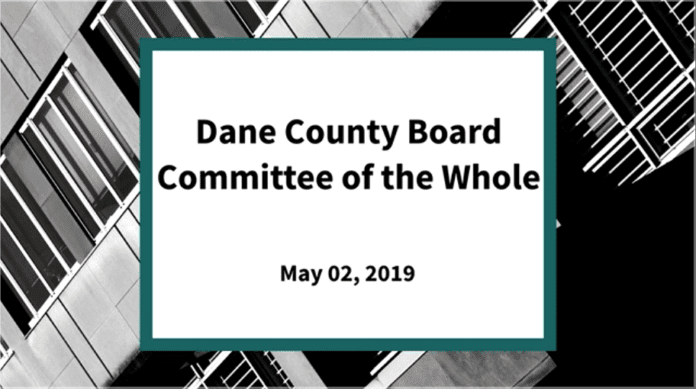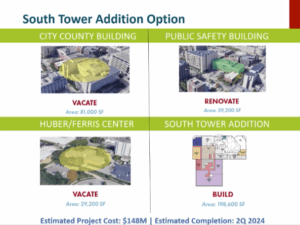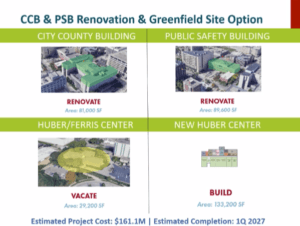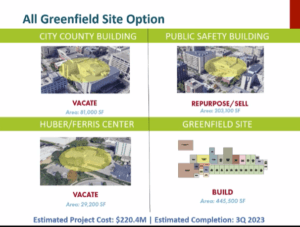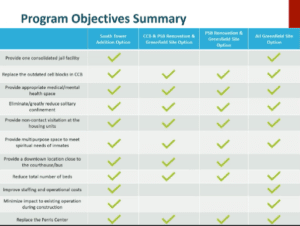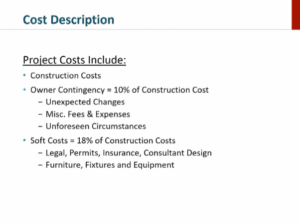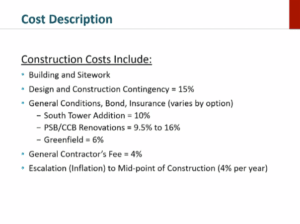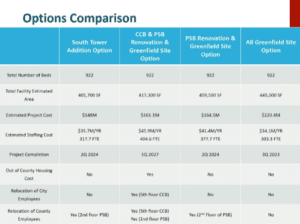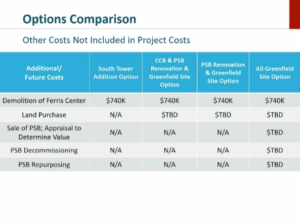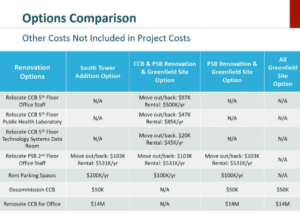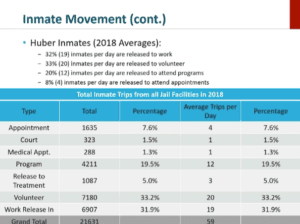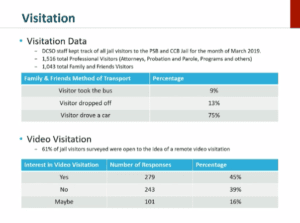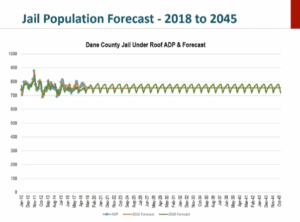Last week the press started telling us the details of the 4 jail options. Thursday the County Board met in as a “Committee of the Whole” an hour before the County Board meeting to hear a presentation from Mead and Hunt (this blog post is primarily that meeting). Tonight, two county board committees are deciding which alternatives they want. Slam bam thank you mam and public input and racial equity analysis be damned. The last jail option was $76M, not we’re up to $150M and we’re being told its the best they can do. Is it? Is it really? To put it in context, the entire capital budget for the past 10 years has averaged less than $50M, for all project (county roads, buildings, land purchases etc)
Background, Meeting tonight
From Supervisor Wegleitner:
Last Thursday, the County Board met as a committee of the whole (COTW) to receive the report from Mead & Hunt (architect and engineer firm), Gilbane (construction firm), and the Sheriff regarding four options for a new county jail. The presentation can be read and streamed here on the Madison City Channel. Last week (prior to the presentation) it was reported that County Executive Parisis and County Board Chair Corrigan support the South Tower option consolidate all three jail facilities by building a new tower (as high as the Courthouse) behind/adjacent to the Public Safety Building (PSB). This option costs $148M and approx $225M when you include interest on the money borrowed over 20 years. It would add a total of $1000 on the property tax bills of the average county household. It is expected to be completed by June 30, 2024 (a little over 5 years from now).
This Tuesday, the Public Protection and Judiciary Committee (PP&J) and the Public Works and Transportation (PW&T) Committee of the County Board will convene for a joint meeting to discuss the options and possibly make a recommendation. The joint meeting begins at 5:45 PM in room 354 of the City-County Building (CCB) at 210 Martin Luther King, Jr. Blvd. Here is the agenda We are organizing a brief teach-in prior to the meeting at 5 PM on the first floor of the CCB to help folks who are interested in registering or offering public comment to the committees. Here is a link to the facebook event. Please rsvp and share with your networks!
I expect there will be a motion at the committee to recommend the South Tower option. A resolution would then be introduced at the next County Board meeting on May 16, be referred to those committees and the Personnel & Finance Committee, and then return to the County Board floor for a vote on June 6 or June 20.
I have reserved the same meeting room for a community organizing meeting on Wednesday, May 15, 2019 from 5:45 PM – 7:45 PM. Please mark your calendars and spread the word.
I have attached and linked to materials that we distributed and/or discussed at the meeting last Wednesday. County Supervisor and Committee info Recommendations regarding Alternatives, Diversion, and Data Status of Resolution 556 Recommendations Res 556 Recommendations Data and Dashboards on Criminal Justice Council page Putting $150M in Perspective Thanks to Brenda for her help with the fact sheets and blogging.
Thursday’s Presentation and Questions
Here’s the video if you want to watch it yourself
Getting Started
There are many people absent for the roll call: Salov, Schauer, Stubbs, Danner, Downing, Erickson, Jones, Knoll, Kuhn, Miles but they still have quorum.
Corrigan explains this is a committee of the whole to hear from the alternatives design study. There will be a presentation and then they can ask questions at the end.
Presentation
Sheriff Mahoney thanks them for scheduling the committee of the whole to provide the most recent study. There are three additional options they want to present and get questions, and they can ask questions on the annex option as well. He introduces David Way (sp? – funny, no one seems to want to put their name on this work) from Mead and Hunt and their team.
David Way, Mead and Hunt, Dude in a Suit, does all the pleasantries, figures out how to use the microphone, then says that Mead and Hunt are the lead firm in the project and study. He introduces “the team”, Potter Lawson, HDR and Gilbane. And then the thank you to county staff. He says they will review the options tonight, its a high level overview and he understands that most of them have received the final report pdf electronically. They won’t get into the weeds on the info and do a high level overview and allow them time to ask questions. He says they will talk about the high level overview, the parameters, the costs and compare the options. They will talk about the schedules as well. They have some additional information from the Sheriff’s office that answers the questions the committee had. He says they have 4 alternative design options, the South Tower addition and then the County Board Chair and County Exec said well, we should probably step back and take a look at other options. (Funny, I thought it was the Public Protection and Judiciary Committee and Public Works and Transportation Committee that asked for that. Hmm.) The other options were the “CCB & PSB Renovation & Greenfield Site” which is a smaller greenfield site, “PSB Renovation and Greenfield Site” which has a larger greenfield site and “All Greenfield Site” where everything is consolidated but off the Isthmus. (CCB = 6th and 7th floors of the City County Building or “old jail”, PSB is the “new jail” or Public Safety Building) He says they lined up the slides so they could compare apples to apples. He says that in all options the Feris Center by the Alliant Energy Center is vacated.
In the South Tower option they are vacating the 6th and 7th floor of the City-County Building. They are renovating 59,000 square feet of the Public Safety Building and building the south tower addition which would be adjacent and there will be one facility in the end. They will talk about the costs more, but he put the cost on the bottom of the slides. This one is the cheapest, it cost $148,000,000 and won’t be done until the 2nd quarter of 2024.
The second option is the CCB & PSB Renovation and Greenfield Site Option. Feris Center is vacated. 6th and 7th floor are renovated and then the PSB is renovated, almost the same amount (30,000 more square feet?) and build a new Huber Center on a greenfield site. They didn’t have a specific site so they are general estimates. The cost is $161M and the completion is 2027 which is much later than the others because they need to relocate inmates to get it done, and there are only so many beds out of town and it is a slow process. There are also phases that take long.
The third option the PSB Renovation and Greenfield Site they vacate the Feris Center and the 6th and 7th floors of the City-County Building. Those floors might be office or something like that, but it won’t be a jail function. They will renovate 62,000 of the PSB and then have an 256,400 square foot greenfield site. The cost is about $164,000,000 and it will be done 2nd quarter 2024.
The fourth option is the all greenfield option. Huber Center, 6th and 7th floor are vacated and the PSB is repurposed or sold, and then everything is on location. It’s a more efficient building, the shortest time to build because it won’t impact the current operations. It costs $220,000,000 and will be completed 3rd quarter of 2023.
This chart compares the parameters of the projects. These have been consistent throughout. They provided the same functions as the 2016 study. This board has been interested in providing more medical and mental health space and reducing solitary confinement and having adequate visitation and multi-purpose needs. So this is a side by side comparison. They want to show them that the South Tower option checks off all the boxes, some of them couldn’t. And there is additional staffing and operational costs. The only one the Greenfield doesn’t check is the location. These are the side comparisons.
Before he gets into the costs he wants to show them sometimes project costs and construction costs are used interchangeably, but project costs include contingencies. For this project they estimate a 10% contingencies to take care of unexpected items or things they want to add. he wants to make sure everyone understands these industry terms. There are also soft costs, which are legal, permits, insurance, consultants fees and FF&E (Furniture, Fixtures and Equipment) or what his colleague calls what happens if you take a building and tip it upside down, its everything that falls out, that’s FF&E. You have to include those costs in the total project costs.
When you break down the construction costs, the building and site. They put another contingency at this level because it is preliminary and as they get further they will understand the costs better. The 15% will go down over time. General Conditions vary for each of the sites, for greenfield there isn’t a lot of risk because they are not downtown, so that cost would be lower. You also have contractor fees and escalation.
The put the comparison side by side to show that the total number of beds which is a reduction, is consistent in all projects. The square foot is about the same, a little higher in the greenfield. The lowest cost is the tower, the middle ones are next and then the most expensive is the greenfield site. Staffing costs are in addition to the project costs, they have to be paid yearly. There was a staffing study along with this with another consultant that came up with these numbers. For this option he came up with $36M per year and it goes into the 40s and down for the greenfield because it is more efficient. For completion is the greenfield site, then the south tower and then the middle ones. The second one is quite a bit longer. On housing costs, there is significant costs with option 2, there aren’t any for the other options. It would be $5-15M for the 2nd option. If they did remodel the 6th and 7th floor of the City County Building they would need to vacate the 5th floor during that time. With the other options, there are county employees that might need to be relocated, if the 3rd floor is renovated the 2nd floor would need to be relocated.
There are other costs that are associated with this, the demolition of the Feris Center, it’s $740,000 to take that building down. Land purchases, there is no cost with the South Tower because the county owns the land. If they go with land the county doesn’t own, then there is more time and money involved with that. Sale of the PSB needs to be defined if that option is chosen. Also the PSB decommissioning if the greenfield option is selected.
He said there were other costs he didn’t feel they need to go into, but there are relocation costs, moving, rentals. They worked with county staff to figure that out. 5th floor has public health and the data center and you don’t want to have that there during construction. Again, there are other costs that are not significant like parking costs for the south tower, and decommissioning and renovation costs. If you took the 6th and 7th floor and got rid of the cells and turned it into office space, it would cost $14M.
He shows the schedule. They all start about the same time, the shortest is the greenfield site, and second is the south tower. The 2nd option really extends out. That is their high level overview.
Dane County Sheriff Lieutenant Jeff Heil is there to answer questions. The sheriff office staff talked to jail administrators and sheriff’s outside of Dane County to find out what space might be available. Unfortunately, there is a lot of need for jail space in Wisconsin and they found there were not a lot of medium and maximum security beds. This was an important discovery because it impacted the timeline for the City-County Building renovation option because we’d have to do it in phases because we can’t ship out large quantities of inmates.
A big piece of the discussion was about moving inmates between the jail sites and the courthouse and what that would cost. They found that in 4 years of data that they collected from the bailiffs that about 17 inmates a day go to the courthouse. And the range is between 42 and 3. The lowest number is the end of the year prior to New Years. This is seasonal, in the summer they have more people going to court.
Other inmate movement that would impact the facility options the Huber work release inmates, and they tracked what they leave for.
They go out for work (about 1/3 do that) and they leave for volunteering and AODA treatment. There are about 59 inmates leave per day and they looked at the transportation options for people leaving the jail.
They also looked at visitation for a month in March of this year. They kept track of professional (attorneys and service providers), and the personal family and friends visits. They found people took the bus or got rides and a lot of them drove their cars. Parking and transportation is important for the visitors. They also asked the people coming for in person visits if they offered video visitation to supplement the in person visitation if they would be interested in that. And you can see that a majority of the inmate visitors are interest in that.
Chief Deputy Jeff Hole comes to talk about the jail population. They did two jail population forecast studies, one in 2016 study and Dr. Patrick Jablonski population projects. That is where they came up with the whole deal where they could have 922. After we had decided to move forward with the option on top of the jail and we set up the review committee, one of the committee members Ralph Jackson asked if the population projections are still on track. Since wit was 2 years later they brought Dr. Jablonski back and he looked at the 2016-2018 data and they were within fractions of a percent where they were. The 922 number is sufficient if they all continue to work together in all of the programs. The sheriff will touch on this. That is the key to all of this, we need to continue doing the programs we have and do the new programs we agreed to move forward with.
Sheriff David Mahoney comes back up for all the thank yous. He says a lot of hard work went into these 4 options for your ultimate decision. He says that we heard from them and community members that we want to reduce the number of beds, we feel comfortable reducing to 922 beds, but it will require everyone in the criminal justice system to look for ways to divert people. It will require continued funding of the programs, to address mental health and have other options than the criminal justice systems. They are committed to reducing the beds, providing a consolidated jail, to replace our outdated, dangerous, inhumane Dane County Jail and the cells that every day are jeopardizing our population. Those are our neighbors who find themselves incarcerated. It will create medical and mental health beds for the first time since 1954, to appropriately and humanely house those with special needs. For the first time they will be able to eliminate or greatly reduce solitary confinement. We know that is important to you and the citizens we serve. In Dane County we have high values even when we incarcerate our neighbors and we can only do that if we change how we house people in our jail. It will allow us to continue contact visits, I heard that as a priority from you. It will for the first time have recreation available for everyone in jail. It will allow programming, instead of just locking people out. It will create natural light and healing that doesn’t exist today. He hopes we are at the end of studies. Since 1992 they have invested in 14 studies that cost $4M and what do we have to show for it – three ring binders full of pretty color paper. The time is today, in which we make a decision based on our values for Dane County citizens, how we will house and value those who we care for charged to the safety and welfare of the criminal justice system in our jails. He doesn’t think today our environment meets our values. So we need to make a decision to move forward with one of these 4 options or we need to change our value systems.
Questions
David Way from Mead and Hunt steps up to direct the questions.
Carousel Bayrd says she has three questions about the greenfield site. She has talked about this before and is not in favor of it. She says 3 of them have a greenfield site and none of them include the cost of the land correct? Yes. She asks how much time they have added for zoning and community approval. They say they haven’t added that in there because they couldn’t determine what it would be. Someone yells out 5 months. He says if the county owns the land it would be shortest, but it could be longer. The third question is about courthouse having room for bringing a whole bus load of people every day. Sheriff Mahoney says there is a temporary holding facility in the court house, based on the numbers today, there would probably be adequate space, they would have to do a couple of runs. There would be adequate space.
Andrew Schauer asks if all 4 options are viable, are we absolutely convinced or will we run into more trouble. David Way from Mead and Hunt says yes, they are not adding on top of any buildings, but there is less definition in the middle two but they accounted for it in contingencies. He says that is the only thing about this that gives him any heartache at all, each time we do this it gets harder and harder to pass. He asks if they agree on the South Tower option, that is cheapest up front but the greenfield might be less to operate over time. Way says that yes because it is a more efficient system to operate, the tower is 8 stories and less efficient with space and to operate because its a smaller site. Shauer says the trade off is that we get one facility in close proximity to the courthouse. Yes. He adds there is room for 40 inmates in the courthouse. Shauer says that he hopes they can pass this quickly and he appreciated their time and efforts and asks them to bring this to a close quickly.
Heidi Wegleitner asks about staffing costs, 272 FTEs are in our 2019 budget, which she believes is the staffing for the 3 jail facilities, but the tower has an additional 45.7FTEs and $2.2+M in staffing. Why? She can’t find that information in the report. Jeff Hole says that the staffing is confusing, but today’s staffing and the south tower option is $500,000 above what we are spending now. When they agreed to the portion built on top of the jail they agreed to 6 additional officers over today’s staff, and that is about $500,000. This is the same, they added 6 staff. If you look at the three sites, that is $10M over the south tower, which is $10.5 over today. The greenfield is $1.6M less. But if you look at the difference in capital costs it would take 40 years to make that up. Wegleitner asks what positions are included that aren’t in the budget now. Hole says he doesn’t understand the question. He says that this is all staff in security services. They have staff specifically assigned to security services and then those assigned elsewhere. They also have task force which can move and work anywhere, bailiff, jail or patrol. To do the studies they take all the staff hours and figure it out. Even tho when you look at the budget and they are not specifically assigned. Task Force saves them money, makes it efficient but it makes the budget confusing and it doesn’t seem to work out. Wegelietner asks if the Task Force people are included in this report, he says yes. She asks about the statement that they are using the results of the mental health study, what “mental health improvements” they are counting on for the reduced amount of beds. She says that the study just got underway, how are they using that information. Hole says he can’t tell her that, he didn’t give them form or document. He can tell her what they have said before, they need everyone in the system to keep working on everything they are working on. That includes all of the work in the mental health field, the DAs office, the clerk of courts, the Criminal Justice Coucnil, they all need to work on keeping the jail population down. But that piece of paper you have, we did not give that to you from the sheriff’s office.
Heidi Wegleitner asks the sheriff about the 922 which is a reduction of 91 beds, and right now we have about less than 100 people on electronic monitoring. Isn’t is true that you said that County Executive Falk had asked for 200 people to be out. Mahoney says in 2006 when they were shipping 200 inmates a day, they were looking for a way to bring them back. They said with additional staff and resources from 30 to 200. The maximum they ever hit was 185. The reason it is under 200 is because of all the other efforts – drug court, bail monitoring etc. Everyone assigned to the Dane County Jail is assessed to be put on electronic monitoring. 9000 total people have served sentences in their home over the past 12 years. Wegleitner asks about analyzing the eligibility and screening for that program, have they looked at it with an equity lens. He says that the criteria they use came from victim advocates. They continue to review it and will expand the best they can.
Corrigan cuts Heidi off, says she’s been asking questions for 10 minutes and others have to allow others to ask questions, so only one more question.
Wegleitner asks if there has been an equity analysis that was done. He says “I don’t believe so”.
Carl Chenowith asks about the contingencies, are they included in the price or is that additional. Way asks which costs? Construction. He says the contingencies are much different downtown than greenfield. They say yes.
Paul Rusk asks Supervisor Bayrd’s question again, how can we possibly have the greenfield site be the shortest time line if we don’t have a site identified. It took years to come up with a site for the homeless day center, how are we going to have that be the shortest time. Way says that they couldn’t guess that. They normalized it on the timeline. If you go to a greenfield site and don’t have the land you will need to account for that. He also asks about eliminate or greatly reduce solitary confinement. Most people in the room want it eliminated. Sheriff says that currently they use it when people are brought to jail, to sober up, to reduce stress level to the point they can follow directions. Those won’t go away. The others will be eliminated. We won’t have 40-50 people per day? It will be in a dayroom, not 6 foot by 9 foot. They are in a sub housing unit, they can come out of the cells, they have glass and can see others. The idea is to have them see what is going on an want to be there so they change their attitude, as opposed to a window where they need to stand.
Jeremy Levin asks about the difference between a 8 and 10 story building. It says 8 stories but it has mezzanine’s. Way says they are building up to the capital height limit, it will appear to be 10 stories, it will be about the same height as the court house. Levin also asks if there is any amount of floors that can be added to the jail. He says that is one of the appendixes in the report and they are recommending nothing be added.
Yogesh Chawla asks about the life the buildings. The PSB was built in the 1990s and its been described as deteriorating, can you tell us what the longevity of each of the options is. Typically they build for 50 years. PSB has some maintenance and plumbing issues, that was the result of bad piping installed. That will need to be dealt with in the renovation. At 50 years its doesn’t crash and burn, it will last longer with proper maintenance. Chawla asks how much of the price is investments to improve the current building. They say they didn’t look at that.
Yogesh Chawla asks Chuck Hicklin, their Controller, how will the debt be structured and what is the total cost? After we pay it all back, what would it cost. Hicklin says that repayment with principal interest over 20 years, for the South Tower its about $225M. They would not borrow all of it, they would authorize it, but they would borrow to have cash available for the payments. They would borrow some in 2020, some in 2021 and some in 2022. They would work with the construction manager on the timing of the construction draws. He says with the court house it was only 40M but they borrowed that in different years. Chawla says $148M paid back over 20 years its $225? Yes, similar to that.
Corrigan announces that they will go a little over their one hour limit because there are people waiting to ask questions.
Dorothy Krause says that in the early discussions they had a wish list and we pared that down, in the 4 options, if we want to reserve room for expansion to add back the options we let go of, which of those would have room to add back extra programming we had to eliminate. Way says with the South Tower they had looked at buying the the Carpenter building, the apartment and house next door. That would be the option. The middle two there is no more room at CCB or PSB. If they went to the greenfield site that would be the easiest and best option for expansion. Jeff Hole says that they are not touching the 2nd floor of the public safety building, so they could be moved to the 6th and 7th floor of the CCB.
Matt Veldran asks about the demo, will it always cost $14M. Way says yes, that is demo and to create office space. He asks about the additional cost to dig down for the south tower, the cost of the footing. Way says they need to go down two levels to match up to the existing building. Veldran thought that was additional costs. Turns out it is the same either way. Veldran asks why the greenfield is more expensive for construction. Way says because they are building everything, there is nothing to build on to. Veldran asks about 18% ????? Is that typical? (Talking off camera . . . can’t hear) Veldran asked about the mental health issues, how many people would be impacted by that. Jeff Hole says it was addressed in the 2016 report and if we do everything we talked about, about 16-17 people would be diverted from the jail. We need to do that to make the 922 a real target. Veldran asks Judge Colas about the 40 inmates we can hold at the courthouse. What does that represent in a day. Hole says that they average is 17 a day, but as low as three and high as 40.
Wegleitner asks about them stopping mitigation efforts in the CCB, what was done, how much money was spent and when did that stop and why. Mahoney says they looked at it today. They approved $5,715,000 for addressing the locks and mitigation, as well as creating some lighting and markings for emergency exits in case they needed to evacuate. Part of the money went to increasing the number of cameras. This was all to get us by for 3 years. Most of the locks have been replaced, some continue to fail because of other issues in the doors. They continue to buy cameras, but they are trying to be mindful to the taxpayer dollars. The initial study was that it would cost $48M in the long run, and $17M more for additional staffing. As they move forward, they are 3 years past what they said on the mitigation and if they kept going they would need $48M. Wegleitner asks if they are continuing or is it on a pause. Sheriff says they are putting in cameras and monitors but in a holding pattern while the board decides. How long have you been in a holding pattern, he says when they ran out of the money. Wegleitner says much of the money went to lead abatement. Sheriff says that they had to hire a group to do lead abatement, they also found out they had high level of lead in the water being consumed, so they had to put in a filter as well. Wegleitner asks again, when did they run out of money? Sheriff says that part of the dollars went to the fire alarm system and the cameras and monitors. So, the money is still there but they encumbered it for a different purpose.
Krause asks about the 3 options for a greenfield site. Is there a formula for how many acres we need for each of them. The architect says that the greenfield site is 12 acres, 18 acres and 20 acres. There is no formula for that, but . . . talking off camera and I can’t hear.
Corrigan stops the meeting, they adjourn. They come back to the next meeting in 5 minutes.

